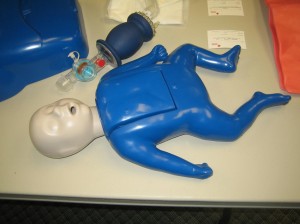Pediatric cases of cardiac arrest

When children get a heart attack, the cause is very different from when heart attacks occur in adults. Primarily, heart attacks in children are caused by severe respiratory problems. When a child experiences respiratory failure, it leads to a cascade of symptoms that end in cardiac arrest. With this in mind, the rescuer has to remember the importance of ventilation in pediatric cases.
Because the child will most likely experience both cardiac and respiratory arrest, both chest compressions and rescue breaths have to be given adequately. This is different from adult rescues, because adult victims usually experience cardiac arrest with irregular breathing (gasping). In this case, poor oxygen delivery to the tissues is due to poor circulation, not ventilation problems – which is why chest compressions are more important than rescue breaths.
What happens in a heart attack?
Heart attacks happen when the cardiac muscle ceases to function, either due to a problem with the delivery of blood to the heart or the heart’s electrical impulses. Fatty deposits called plaques can build up in the vessels that supply the heart with blood, causing ischemia. Ischemia causes irreversible tissue death, resulting in a myocardial infarction. Electrolyte imbalances can also cause electrical impulses to become irregular, resulting in arrhythmias.
Pediatric Advanced Life Support training
Advanced Life Support training has two programs under it, ACLS for adult cases and PALS for pediatric cases. PALS stands for Pediatric Advanced Life Support. In ALS training, the focus is on medical management, rather than the basics (Basic Life Support courses). Because basic skills aren’t the focus of ALS programs, we require the trainees to enroll in the Basic Life Support for HCPs program first.
Program details
The PALS training program is completed in several sessions over 2 days, with 16 hours total. A re-certification course accompanies our PALS program, for rescuers who want to renew their training certificates. Certificates are only valid for two years before they have to be renewed (before the expiration date).
Requirements for this program include taking a pre-test (and passing) and having a valid Basic Life Support for HCPs credential. At the end of training, the student has to pass the certification exam before he or she is awarded the PALS credential.
Provider locations and enrollment
We offer the most convenient ways of enrollment with our providers. Located in six cities all over the US, students can sign up for training through the internet, telephone, or in person. Each of our locations has its own website and online application form that can be filled out at any time of the day. Similarly, if the student wants to make inquiries through e-mail, they can be sent at any time as well. Telephone calls and walk-ins have to be done during business hours only.
Locations
- Los Angeles, CA
- San Francisco, CA
- Honolulu, HI
- Las Vegas, NV
- Portland, OR
- Seattle, WA
